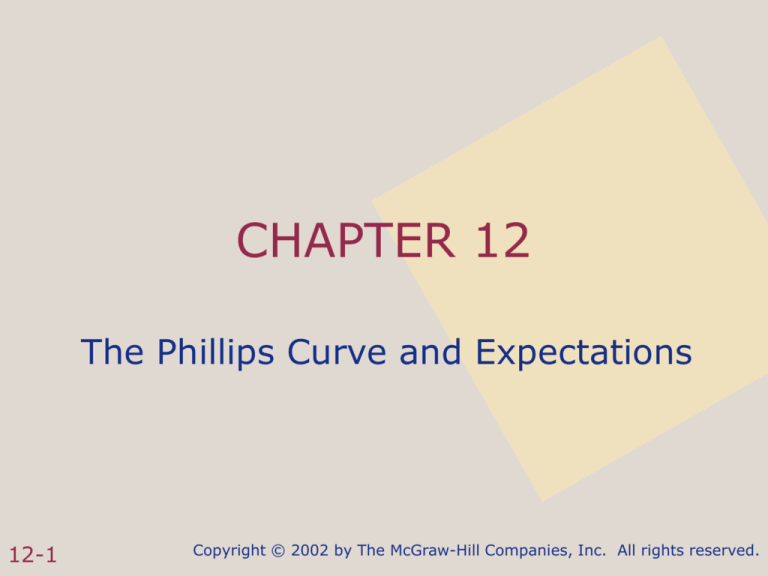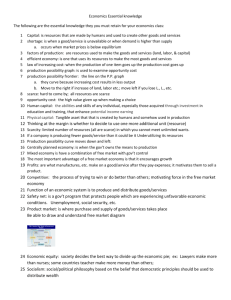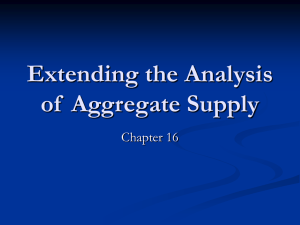
CHAPTER 12
The Phillips Curve and Expectations
12-1
Copyright © 2002 by The McGraw-Hill Companies, Inc. All rights reserved.
Questions
• What is the Phillips curve?
• How has the natural rate of
unemployment changed in the U.S.
over the past two generations?
• What determines the expected rate of
inflation?
• How can we tell how expectations of
inflation are formed--whether they
are static, adaptive, or rational?
12-2
Copyright © 2002 by The McGraw-Hill Companies, Inc. All rights reserved.
Questions
• How useful is the aggregate demandaggregate supply framework--the ISLM model and the Phillips curve--for
understanding macroeconomic events
in the U.S. over the past two
generations?
• How do we connect up the stickyprice model with the flexible-price
model?
12-3
Copyright © 2002 by The McGraw-Hill Companies, Inc. All rights reserved.
Okun’s Law
• Okun’s law shows the relationship
between the unemployment rate and
real GDP
Y - Y *
u - u* -0.4
Y*
• or
Y - Y *
-2.5 (u - u*)
Y*
12-4
Copyright © 2002 by The McGraw-Hill Companies, Inc. All rights reserved.
The Three Faces of
Aggregate Supply
• Aggregate supply relates the price
level to the level of real GDP
• Aggregate supply can also relate the
inflation rate to the level of real GDP
• Using Okun’s law, aggregate supply
can also relate the inflation rate to the
unemployment rate
– this relationship is known as a Phillips
curve
12-5
Copyright © 2002 by The McGraw-Hill Companies, Inc. All rights reserved.
The Phillips Curve
• Aggregate supply can relate the
inflation rate to the level of real GDP
Y - Y *
e
( - )
Y*
• The right-hand side of this equation
can be substituted into Okun’s Law
- 2.5 (u - u*) ( - e )
2.5
(u - u*)
e
12-6
Copyright © 2002 by The McGraw-Hill Companies, Inc. All rights reserved.
The Phillips Curve
• Letting =2.5/, we get the Phillips
curve
e - (u - u*)
• To allow for supply shocks, we will add
an extra term to the Phillips curve (s)
e
- (u - u*)
12-7
s
Copyright © 2002 by The McGraw-Hill Companies, Inc. All rights reserved.
Figure 12.1 - The Phillips Curve
12-8
Copyright © 2002 by The McGraw-Hill Companies, Inc. All rights reserved.
Figure 12.2 - Three Faces of Aggregate Supply
12-9
Copyright © 2002 by The McGraw-Hill Companies, Inc. All rights reserved.
The Phillips Curve
• The slope of the Phillips curve
depends on how sticky prices and
wages are
– the stickier are wages and prices, the
smaller is parameter , and the flatter is
the Phillips curve
• When the Phillips curve is flat, even
large changes in the unemployment
rate have little effect on the price
level
12-10
Copyright © 2002 by The McGraw-Hill Companies, Inc. All rights reserved.
The Phillips Curve
• Whenever unemployment is equal to
its natural rate, inflation is equal to
expected inflation
– the position of the Phillips curve can be
determined if we know the natural rate of
unemployment and the expected inflation
rate
12-11
Copyright © 2002 by The McGraw-Hill Companies, Inc. All rights reserved.
The Phillips Curve
• The Phillips curve shifts if either
expected inflation or the natural rate
of unemployment changes or if a
supply shock occurs
– a higher natural rate moves the Phillips
curve to the right
– higher expected inflation moves the
Phillips curve up
– adverse supply shocks move the Phillips
curve up
12-12
Copyright © 2002 by The McGraw-Hill Companies, Inc. All rights reserved.
Figure 12.3 - Shifts in the Phillips Curve
12-13
Copyright © 2002 by The McGraw-Hill Companies, Inc. All rights reserved.
Aggregate Demand
• The aggregate demand function
developed in Chapter 11 shows how
real GDP relates to the inflation rate
Y Y0 - '( ' )
• We can use Okun’s Law to develop an
aggregate demand equation with
unemployment on the left-hand side
u u0 - ( ' )
12-14
Copyright © 2002 by The McGraw-Hill Companies, Inc. All rights reserved.
Aggregate Demand
u u0 - ( ' )
• The parameter is the product of
three things
– how much the central bank raises the
real interest rate in response to inflation
– how much real GDP changes in response
to a change in the real interest rate
– how large a change in unemployment is
produced by a change in real GDP
12-15
Copyright © 2002 by The McGraw-Hill Companies, Inc. All rights reserved.
Equilibrium Levels of
Inflation and Unemployment
• Together, the unemployment form of
the aggregate demand relationship
and the Phillips curve equation allow
us to determine what the inflation and
unemployment rates will be in the
economy
– the economy’s equilibrium is where the
two curves cross
12-16
Copyright © 2002 by The McGraw-Hill Companies, Inc. All rights reserved.
Figure 12.4 - Equilibrium Levels of
Unemployment and Inflation
12-17
Copyright © 2002 by The McGraw-Hill Companies, Inc. All rights reserved.
Equilibrium
• The economy’s equilibrium inflation
and unemployment rates depend on
– the natural rate of unemployment (u*)
– the expected rate of inflation (e)
– supply shocks (s)
– the level of unemployment when the real
interest rate is at what the central bank
thinks is its long-run average (u0)
– the central bank’s target level of inflation
(’)
12-18
Copyright © 2002 by The McGraw-Hill Companies, Inc. All rights reserved.
Solving for Equilibrium
• To solve for the equilibrium
unemployment rate, substitute the
Phillips curve equation into the
monetary policy reaction function
1
e
u
u0
u *
( ' )
s
1
1
1
1
12-19
Copyright © 2002 by The McGraw-Hill Companies, Inc. All rights reserved.
Solving for Equilibrium
• To solve for the equilibrium inflation
rate, substitute the monetary policy
reaction function into the Phillips
curve
1
1
e
'
(u * u0 )
s
1 1
1
1
12-20
Copyright © 2002 by The McGraw-Hill Companies, Inc. All rights reserved.
A Decrease in Exports
• If export demand falls, and the central
bank does nothing, u0 will rise by u0
• The effect on the equilibrium level of
unemployment will be
1
u
u0
1
• The effect on the equilibrium level of
inflation will be
-
u0
1
12-21
Copyright © 2002 by The McGraw-Hill Companies, Inc. All rights reserved.
Figure 12.5 - Effects of a Fall in Exports
12-22
Copyright © 2002 by The McGraw-Hill Companies, Inc. All rights reserved.
The Natural Rate of
Unemployment
• Unemployment cannot be reduced
below its natural rate without
accelerating inflation
• If the natural rate of unemployment is
high, expansionary fiscal and
monetary policy are largely ineffective
as tools to reduce unemployment
• Most estimates of the current natural
rate in the U.S. lie between 4.5 and
5.0 percent
12-23
Copyright © 2002 by The McGraw-Hill Companies, Inc. All rights reserved.
Figure 12.6 - Fluctuations in Unemployment
and the Natural Rate
12-24
Copyright © 2002 by The McGraw-Hill Companies, Inc. All rights reserved.
The Natural Rate of
Unemployment
• Four sets of factors influence the
natural rate of unemployment
– demography
• the relative age and educational distribution
of the labor force
– institutions
• labor unions, worker mobility, taxes
– productivity growth
• wage growth
– past levels of unemployment
12-25
Copyright © 2002 by The McGraw-Hill Companies, Inc. All rights reserved.
Figure 12.7 - Real Wage Growth Aspirations
and Productivity
12-26
Copyright © 2002 by The McGraw-Hill Companies, Inc. All rights reserved.
Expected Inflation
• The natural rate of unemployment and
expected inflation together determine
the position of the Phillips curve
– higher expected inflation moves the
Phillips curve upward
12-27
Copyright © 2002 by The McGraw-Hill Companies, Inc. All rights reserved.
Expected Inflation
• There are three basic scenarios for
how inflation expectations are formed
– static expectations
• prevail when people ignore the fact that
inflation can change
– adaptive expectations
• prevail when people assume the future will be
like the recent past
– rational expectations
• prevail when people use all the information
they have as best they can
12-28
Copyright © 2002 by The McGraw-Hill Companies, Inc. All rights reserved.
The Phillips Curve under
Static Expectations
• If inflation expectations are static,
expected inflation never changes
– the trade-off between inflation and
unemployment will not change from year
to year
• If inflation has been low and stable,
businesses will probably hold static
inflation expectations
12-29
Copyright © 2002 by The McGraw-Hill Companies, Inc. All rights reserved.
Figure 12.9 - Static Expectations of Inflation
12-30
Copyright © 2002 by The McGraw-Hill Companies, Inc. All rights reserved.
Static Expectations of
Inflation in the 1960s
• In the 1960s, the Phillips curve did
not shift up or down in response to
changes in expected inflation
– when unemployment was above 5.5%,
inflation was below 1.5%
– when unemployment was below 4%,
inflation was above 4%
• The economy moved along a stable
Phillips curve
12-31
Copyright © 2002 by The McGraw-Hill Companies, Inc. All rights reserved.
Figure 12.10 - Static Expectations and the
Phillips Curve, 1960-1968
12-32
Copyright © 2002 by The McGraw-Hill Companies, Inc. All rights reserved.
The Phillips Curve under
Adaptive Expectations
• If the inflation rate varies too much
for workers and businesses to ignore
it and if last year’s inflation rate is a
good guide to inflation this year,
individuals are likely to hold adaptive
expectations
– inflation will be forecasted by assuming
that this year will be like last year
– forecast will be good only if inflation
changes slowly
12-33
Copyright © 2002 by The McGraw-Hill Companies, Inc. All rights reserved.
The Phillips Curve under
Adaptive Expectations
• The Phillips curve can be written
*
t
t t -1 - (ut - u )
s
t
• The Phillips curve will shift up and
down depending on whether last
year’s inflation was higher or lower
than the previous year’s
– inflation accelerates when unemployment
is less than the natural rate
12-34
Copyright © 2002 by The McGraw-Hill Companies, Inc. All rights reserved.
Adaptive Expectations
• Example
– the government pushes the
unemployment rate down 2 percentage
points below the natural rate
– =1/2
– last year’s inflation rate = 4%
t t-1 - 2
This year’s inflation rate = 4+1/22=5
Next year’s inflation rate = 5+1/22=6
And so on
12-35
Copyright © 2002 by The McGraw-Hill Companies, Inc. All rights reserved.
Figure 12.11 - Accelerating Inflation
12-36
Copyright © 2002 by The McGraw-Hill Companies, Inc. All rights reserved.
Adaptive Expectations and
the Volcker Disinflation
• At the end of the 1970s, expected
inflation gave the U.S. an unfavorable
short-run Phillips curve trade-off
• Between 1979 and the mid-1980s,
Fed chairman Paul Volcker reduced
inflation from 9 to 3 percent per year
• The fall in inflation triggered a fall in
expected inflation
– the Phillips curve shifted down
12-37
Copyright © 2002 by The McGraw-Hill Companies, Inc. All rights reserved.
Figure 12.12 - The Phillips Curve before and
after the Volcker Disinflation
12-38
Copyright © 2002 by The McGraw-Hill Companies, Inc. All rights reserved.
The Phillips Curve under
Rational Expectations
• If the economy is changing rapidly
enough that adaptive expectations
lead to large errors, individuals will
switch to rational expectations
– People form their forecasts of future
inflation not by looking backward but by
looking forward
• they look at what current and expected
government policies tell us about what
inflation will be
12-39
Copyright © 2002 by The McGraw-Hill Companies, Inc. All rights reserved.
The Phillips Curve under
Rational Expectations
• The Phillips curve will shift as rapidly
as changes in economic policy that
affect aggregate demand
• Anticipated changes in economic
policy turn out to have no effect on
the level of production or employment
12-40
Copyright © 2002 by The McGraw-Hill Companies, Inc. All rights reserved.
Government Policy to
Stimulate the Economy
• Suppose that the unemployment rate
is equal to its natural rate and
inflation is equal to expected inflation
• The government takes steps to
stimulate the economy by cutting
taxes and raising government
spending to reduce the unemployment
rate below the natural rate
12-41
Copyright © 2002 by The McGraw-Hill Companies, Inc. All rights reserved.
Figure 12.13 - Government Attempts to
Stimulate the Economy
12-42
Copyright © 2002 by The McGraw-Hill Companies, Inc. All rights reserved.
Government Policy to
Stimulate the Economy
• If the policy comes as a surprise, the
economy moves up and to the left
along the Phillips curve in response to
the change in government policy
• Unemployment will be lower,
production will be higher, and the rate
of inflation will be higher
12-43
Copyright © 2002 by The McGraw-Hill Companies, Inc. All rights reserved.
Figure 12.14 - Results if the Shift in Policy
Comes as a Surprise
12-44
Copyright © 2002 by The McGraw-Hill Companies, Inc. All rights reserved.
Government Policy to
Stimulate the Economy
• If the policy is anticipated, individuals
will take the policy into account when
they form their expectations of
inflation
• The Phillips curve will shift up
• There will be no effect on
unemployment or output
• The rate of inflation will rise
12-45
Copyright © 2002 by The McGraw-Hill Companies, Inc. All rights reserved.
Figure 12.15 - Results if the Shift in Policy Is
Anticipated
12-46
Copyright © 2002 by The McGraw-Hill Companies, Inc. All rights reserved.
What Kind of Expectations
Do We Have?
• If inflation is low and stable,
expectations are probably static
• If inflation is moderate and fluctuates
slowly, expectations are probably
adaptive
• When shifts in inflation are clearly
related to changes in monetary policy,
swift to occur, and large enough to
seriously affect profitability,
expectations are probably rational
12-47
Copyright © 2002 by The McGraw-Hill Companies, Inc. All rights reserved.
From the Short Run
to the Long Run
• In the case of an anticipated shift in
economic policy under rational
expectations, the long run is now
• In the absence of supply shocks
e
- (u - u*)
• If expectations are rational and
changes in policy foreseen, expected
inflation will be equal to actual
inflation and unemployment will be at
its natural rate
12-48
Copyright © 2002 by The McGraw-Hill Companies, Inc. All rights reserved.
Figure 12.16 - Rational Expectations: The
Long Run Is Now
12-49
Copyright © 2002 by The McGraw-Hill Companies, Inc. All rights reserved.
From the Short Run
to the Long Run
• If expectations are adaptive, the
economy will approach the long run
gradually
– an expansionary shock will lower
unemployment, increase real GDP, and
lead to an increase in the inflation rate
– individuals will raise their expectations of
inflation in the next periods
– as time passes, the gaps between actual
unemployment and its natural rate and
actual and expected inflation will shrink
to zero
12-50
Copyright © 2002 by The McGraw-Hill Companies, Inc. All rights reserved.
Figure 12.17 - Adaptive Expectations
Convergence to the Longer Run
12-51
Copyright © 2002 by The McGraw-Hill Companies, Inc. All rights reserved.
From the Short Run
to the Long Run
• Under static expectations, the long
run never arrives
– the gap between expected and actual
inflation can grow arbitrarily large as
different shocks hit the economy
• if the gap between actual and expected
inflation becomes large, individuals will not
remain so foolish as to retain static
expectations
12-52
Copyright © 2002 by The McGraw-Hill Companies, Inc. All rights reserved.
Chapter Summary
• The location of the Phillips curve is
determined by the expected rate of
inflation and the natural rate of
unemployment (and possibly by
current, active supply shocks)
– in the absence of current, active supply
shocks, the Phillips curve passes through
the point at which inflation is equal to its
expected value and unemployment is
equal to its natural rate
12-53
Copyright © 2002 by The McGraw-Hill Companies, Inc. All rights reserved.
Chapter Summary
• The slope of the Phillips curve is
determined by the degree of price
stickiness in the economy
– the more sticky are prices, the flatter is
the Phillips curve
• The natural rate of unemployment in
the U.S. has exhibited moderate
swings in the past two generations
12-54
Copyright © 2002 by The McGraw-Hill Companies, Inc. All rights reserved.
Chapter Summary
• Three significant supply shocks have
affected the rate of inflation over the
past two generations
– the oil price increases of 1973 and 1979
and the oil price decrease of 1986
12-55
Copyright © 2002 by The McGraw-Hill Companies, Inc. All rights reserved.
Chapter Summary
• The principal determinant of the
expected rate of inflation is the past
behavior of inflation
– if inflation has been low and steady,
expectations are probably static
– if inflation has been variable but
moderate, expectations are probably
adaptive
– if inflation has been high or has varied
rapidly, expectations are probably
rational
12-56
Copyright © 2002 by The McGraw-Hill Companies, Inc. All rights reserved.
Chapter Summary
• The best way to gauge how
expectations are formed is to consider
the past history of inflation
– would adaptive expectations have
provided a significant edge over static
ones?
– would rational expectations have
provided a significant edge over adaptive
ones?
12-57
Copyright © 2002 by The McGraw-Hill Companies, Inc. All rights reserved.
Chapter Summary
• How fast the flexible price model
becomes relevant depends on the
type of inflation expectations in the
economy
– under static expectations, the flexibleprice model never becomes relevant
– under adaptive expectations, the flexibleprice model becomes relevant gradually
– under rational expectations, the flexibleprice model is relevant always
12-58
Copyright © 2002 by The McGraw-Hill Companies, Inc. All rights reserved.








